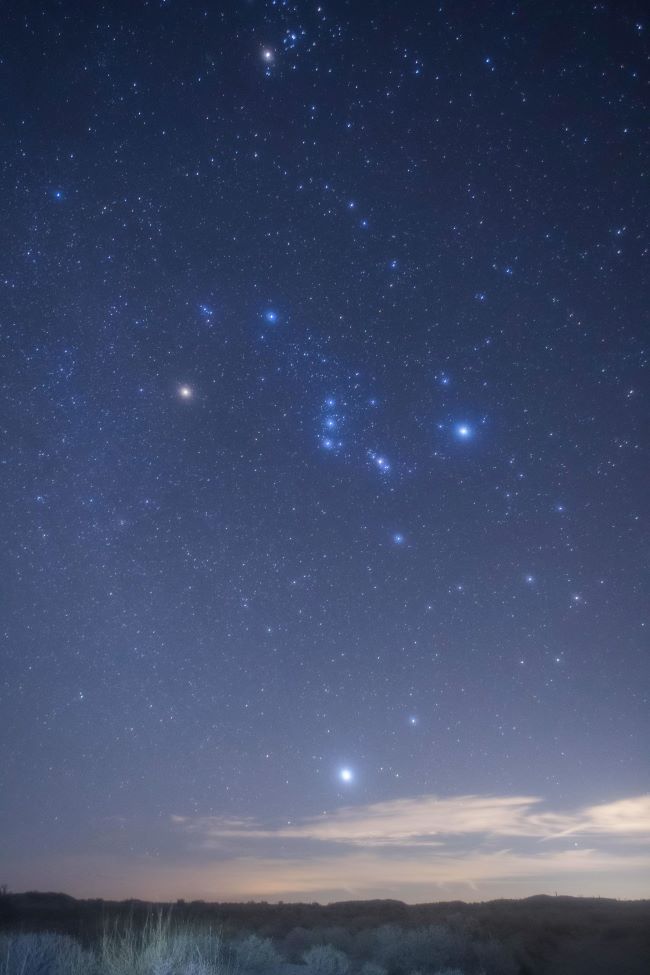
Betelgeuse nearly disappeared
The bright star Betelgeuse did become fainter – and, for experienced observers using the right equipment, nearly disappeared – last night (December 11, 2023). The event occurred as asteroid Leona passed in front of the star. But the event was quick! And it was subtle: a momentary dimming of the star.
El asteroide 319 Leona pasó esta noche frente a la estrella Betelgeuse y parece ser que solo disminuyó su brillantez un par de segundos y no la ocultó totalmente, al menos desde la perspectiva de Italia. "Spikes" o líneas de brillo desaparecen brevemente.
(Video: Antonio Piras) pic.twitter.com/NVV7n5q8gv
— SocAstronomíaCaribe (@Soc_AstroCaribe) December 12, 2023
Translation: Asteroid 319 Leona passed in front of the star Betelgeuse tonight and it seems that it only decreased its brightness for a couple of seconds and did not completely hide it, at least from the perspective of Italy. “Spikes” or glow lines disappear briefly. Video: Antonio Piras.
The post above – from Italy – shows what the eye would have seen: a dimming, but not a total disappearance.
The 2024 lunar calendars are here! Best Christmas gifts in the universe! Check ’em out here.
Report from cyberspace
We also heard from experienced observer and EarthSky community member Eliot Herman in Tucson, Arizona, who said he watched the event online at several different channels. He said:
I watched first in Sardina. It looked maybe 50% decrease for 2 seconds there. Then I flipped to Portugal and saw nothing. Betelguese must either be larger than thought in apparent diameter or the asteroid smaller.
And here’s a light curve
Preliminary light curve of a recording of the stellar occultation of #Betelgeuse by asteroid (319) Leona by M. O'Connell and A. Pratt, located south of Alicante, Spain. Camera Watec 910 HX/RC and 40mm f/4.5 apo with Bessel V filter.? pic.twitter.com/iEeFXSTwOm
— IOTA / European Section (@IOTAEuropeanSec) December 12, 2023
From Córdoba, Andalusia
The video above is from Sebastian Voltmer (@SeVoSpace on Twitter, @spacemovie on YouTube). He was observing at Almodóvar del Río, a Spanish municipality in the province of Córdoba, Andalusia.
Betelgeuse eclipse on December 11 or 12
Betelgeuse is a famous red supergiant star in the constellation Orion the Hunter. Prior to the event, Betelgeuse’s light was predicted to look dimmed or extinguished for up to 7 seconds. But we didn’t see any reports of its dimming for that long (some might still come in).
The event took place at 1:24:54 UTC on December 12, 2023.

Betelgeuse is a temperamental star
Betelgeuse is already famous for how it varies in brightness. And, since 2019, there’s been a noticeable uptick in the brightening and dimming of Betelgeuse. It’s the nearest red supergiant star to Earth, lying some 1,000 light-years away. It will explode someday, though that might be today or thousands of years from now. A paper in 2023 said that it might explode within “tens of years.” That would be amazing to see!
If it were to explode, we would see it as an incredibly bright star, even visible in daylight for roughly a year until it faded away completely, leaving a darkness where Orion’s shoulder was. Fortunately, Earth is too far away for this explosion to harm, much less destroy, life on Earth.

Bottom line: On December 11 and 12, 2023, the star Betelgeuse dimmed, and nearly disappeared, for several seconds as asteroid Leona passed in front of it.











